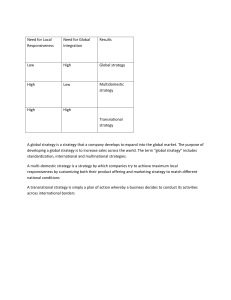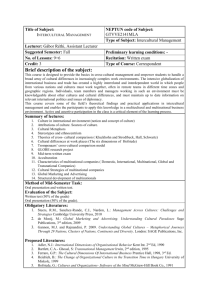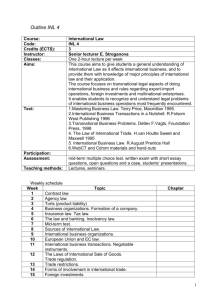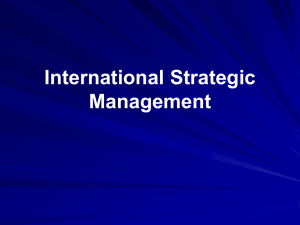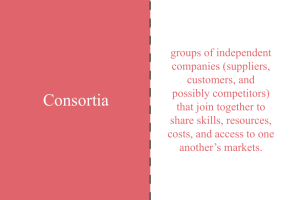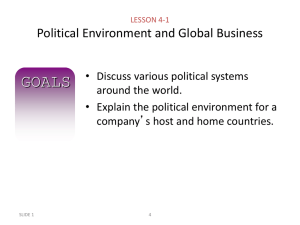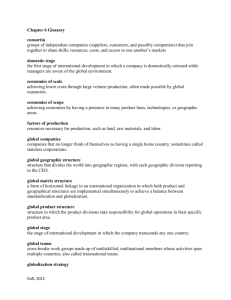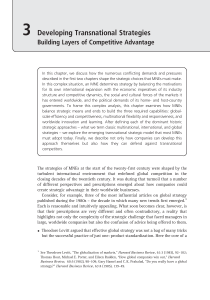Chapter Twenty Three : Organization Development In Global Settings Organization Development and Change
advertisement
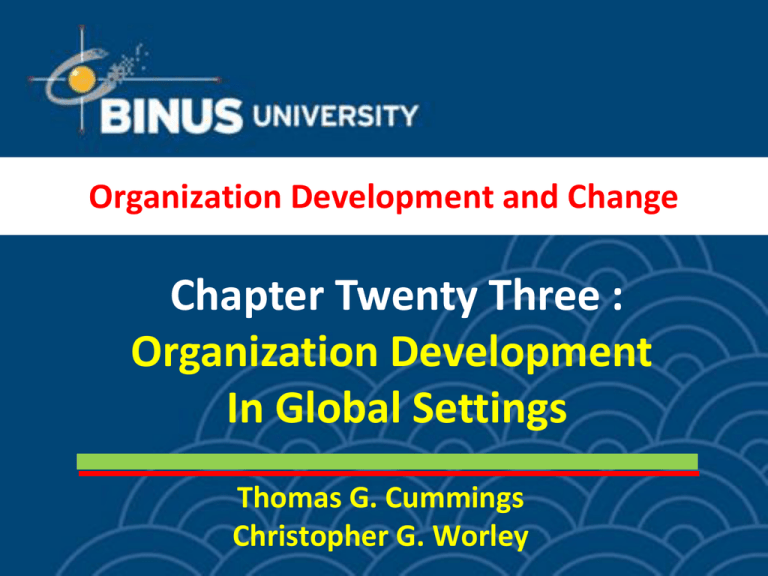
Organization Development and Change Chapter Twenty Three : Organization Development In Global Settings Thomas G. Cummings Christopher G. Worley Learning Objectives for Chapter Twenty Three To explore the differences in OD applications in a cross-cultural context. To understand the cultural values that might impact OD applications in other societies To examine how OD can best be applied in worldwide firms and global social change organizations HS 23-2 Growth of OD in Global Settings The rapid development of foreign economies The increasing worldwide availability of technological and financial resources The emergence of a global economy HS 23-3 Cultural Context Context Orientation Power Distance Uncertainty Avoidance Achievement Orientation Individualism HS 23-4 Context The extent to which meaning in communication is carried in the words Organizations in high context cultures tend to value ceremony and ritual, the structure is less formal, there are fewer written policies, and people are often late for appointments HS 23-5 Power Distance Extent to which members of a society accept that status and power are distributed unequally in an organization Organizations in these cultures tend to be autocratic, possess clear status differences, and have little employee participation HS 23-6 Uncertainty Avoidance The extent to which members of a society tolerate the unfamiliar and unpredictable Organizations in these cultures tend to value experts, prefer clear roles, avoid conflict, and resist change HS 23-7 Achievement Orientation The extent to which people in a society value assertiveness and the acquisition of material goods Organizations in these cultures tend to associate achievement with wealth and recognition, value decisiveness, and gender roles are clearly differentiated. HS 23-8 Individualism The extent to which people in a society believe they should be responsible for themselves and their immediate family Organizations in these cultures tend to encourage personal initiative, value time and autonomy, accept competition, and autonomy is highly valued HS 23-9 Economic Development Subsistence Economies Primarily agriculture-based Industrializing Economies Moderately developed and tend to be rich in natural resources Industrial Economies Highly developed and emphasize nonagricultural industry HS 23-10 Cultural and Economic Contexts of International OD Practice Low Level of Economic Development Moderate High Cultural Fit with OD Practice South Pacific South America Middle East Central America Eastern Europe Asia High India South Africa United Kingdom Scandinavia USA HS 23-11 Worldwide Strategic Orientations Offer products/services in more than one country Balance product and functional concerns with geographic issues of distance, time, and culture Carry out coordinated activities across cultural boundaries using a wide variety of personnel HS 23-12 The Integrative-Responsiveness Framework Need for Global Integration High Global Orientation Transnational Orientation International Orientation Multinational Orientation Low Low Need for Local Responsiveness High HS 23-13 Interventions for Worldwide Strategic Orientations The International The Global Orientation The Multinational Orientation The Transnational Orientation HS 23-14 International Strategic Orientation Characteristics of the International Design Sell existing products/services to nondomestic markets Goals of increased foreign revenues Implementing the International Orientation OD facilitates extending the existing strategy into the new market Cross-cultural training and strategic planning HS 23-15 The Global Strategic Orientation Characteristics of the Global Design Centralized with a global product structure Goals of efficiency through volume Implementing the Global Orientation OD supports career planning, role clarification, employee involvement, conflict management and senior management team building to help achieve improved operational efficiency OD helps the organization transition to global integration from local responsiveness HS 23-16 The Multinational Strategic Orientation Characteristics of the Multinational Design Operate a decentralized organization Goals of local responsiveness through specialization Implementing the Multinational Orientation OD helps with intergroup relations, local management selection and team building OD facilitates management development, reward systems, and strategic alliances HS 23-17 Transnational Strategic Orientation Characteristics of the Transnational Design Tailored products Goals of learning and responsiveness through integrations Implementing the Transnational Orientation Extensive selection and rotation Acquire cultural knowledge and develop intergroup relations Build corporate vision HS 23-18 Global Social Change Organizations Their primary task is a commitment to serve as an agent of change in the creation of environmentally and socially sustainable world futures They have discovered and mobilized innovative social-organizational architectures They hold values of empowerment in the accomplishment of their global change mission They are globally-locally linked in structure, membership, or partnership and thereby exist as entities beyond the nation-state They are multi-organizational and often cross-sectoral HS 23-19 Application Stages of Global Social Change Organizations Build the local organization Create horizontal linkages Using values to create the vision Recognizing that internal conflict is often a function of external conditions Understanding the problems of success Build a network of local organizations with similar views and objectives Develop vertical linkages Create channels of communication and influence upward to governmental and policy-level, decision-making processes HS 23-20 Global Social Change Organizations OD Roles and Skills Stewardship Role Bridging Role Communication Skills Negotiation Skills Networking Skills HS 24-21 2-22
